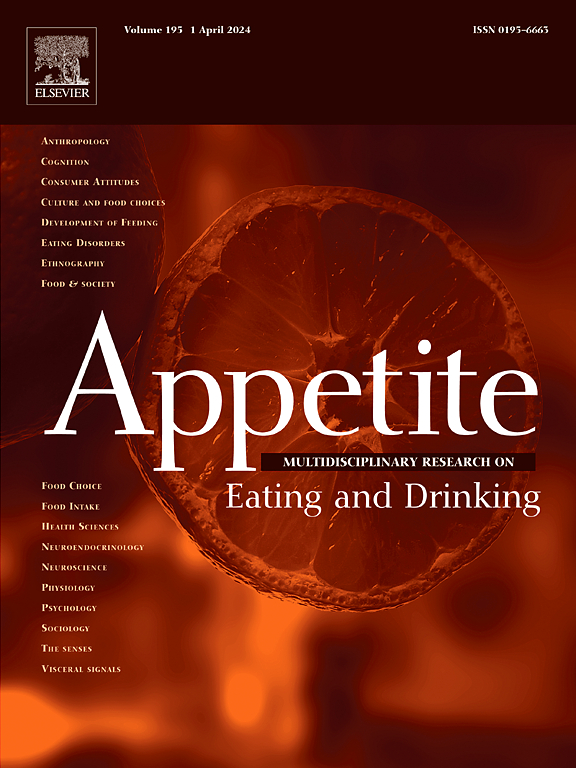Comparing the impact of feedback on excess calories and physical activity calorie equivalent (PACE) information on consumer behaviour in an online hypothetical restaurant setting
IF 3.8
2区 医学
Q1 BEHAVIORAL SCIENCES
引用次数: 0
Abstract
Information provision interventions to improve nutrition in the out-of-home food sector include providing calorie information at point of choice. Supplementary approaches also include providing feedback on physical activity calorie equivalent information (PACE) and/or the extent to which food orders exceed calorie guidelines. However, minimal research has compared the impact these different supplementary approaches have on consumer behaviour. Our aims were to compare the effects of feedback on excess calories ordered, different types of PACE related feedback on decisions to change orders, calories purchased, and calories ordered in a hypothetical online restaurant setting. In an online randomised controlled trial participants (N = 1546) were allocated to receive a restaurant menu with (i) no calorie information on individual menu items, but overall feedback on excess calories ordered (>600 kcals); (ii) calorie information on individual items and feedback on excess calories; (iii) calorie information on individual items and non-specific PACE feedback; (iv) calorie information and personalised PACE feedback based on individual body weight. Outcomes were number of calories ordered after any feedback, and any decision to change items selected after receiving feedback. Receiving feedback on excess calories or exercise required to burn excess calories did not significantly impact the total number of calories purchased. There was some evidence to suggest that presence of feedback on total excess calories without previously seeing the calorie content of individual menu items increased likelihood of participants changing their order. Overall, these findings suggest limited evidence that information provision of feedback on excess calories in different forms has an impact on consumer behaviour in a hypothetical setting.
比较在线假设餐厅环境中对过量卡路里和身体活动卡路里当量(PACE)信息的反馈对消费者行为的影响。
改善家庭外食品部门营养状况的信息提供干预措施包括在选择点提供卡路里信息。补充方法还包括提供关于身体活动卡路里当量信息(PACE)和/或点餐超出卡路里指南的程度的反馈。然而,很少有研究比较这些不同的补充方法对消费者行为的影响。我们的目的是比较在假设的在线餐厅设置中,反馈对超额卡路里订购的影响、不同类型的PACE相关反馈对改变订单的决定、购买的卡路里和订购的卡路里的影响。在一项在线随机对照试验中,参与者(N = 1546)被分配给一份餐馆菜单,其中(1)没有单个菜单项的卡路里信息,但对所点的多余卡路里(600卡路里)有总体反馈;(ii)个别物品的卡路里信息和多余卡路里的反馈;(iii)个别物品的卡路里信息和非特定PACE反馈;(iv)卡路里信息和基于个人体重的个性化PACE反馈。结果是在收到反馈后订购的卡路里数量,以及在收到反馈后改变所选项目的决定。接收关于多余卡路里的反馈或燃烧多余卡路里所需的锻炼对购买的卡路里总数没有显著影响。有一些证据表明,在没有事先看到单个菜单项目的卡路里含量的情况下,对总多余卡路里的反馈增加了参与者改变菜单的可能性。总的来说,这些发现表明,在一个假设的环境中,提供不同形式的多余卡路里反馈信息对消费者行为有影响的证据有限。
本文章由计算机程序翻译,如有差异,请以英文原文为准。
求助全文
约1分钟内获得全文
求助全文
来源期刊

Appetite
医学-行为科学
CiteScore
9.10
自引率
11.10%
发文量
566
审稿时长
13.4 weeks
期刊介绍:
Appetite is an international research journal specializing in cultural, social, psychological, sensory and physiological influences on the selection and intake of foods and drinks. It covers normal and disordered eating and drinking and welcomes studies of both human and non-human animal behaviour toward food. Appetite publishes research reports, reviews and commentaries. Thematic special issues appear regularly. From time to time the journal carries abstracts from professional meetings. Submissions to Appetite are expected to be based primarily on observations directly related to the selection and intake of foods and drinks; papers that are primarily focused on topics such as nutrition or obesity will not be considered unless they specifically make a novel scientific contribution to the understanding of appetite in line with the journal's aims and scope.
 求助内容:
求助内容: 应助结果提醒方式:
应助结果提醒方式:


